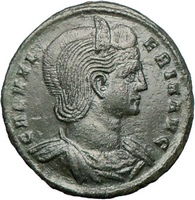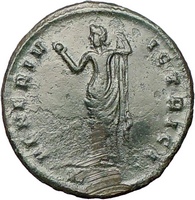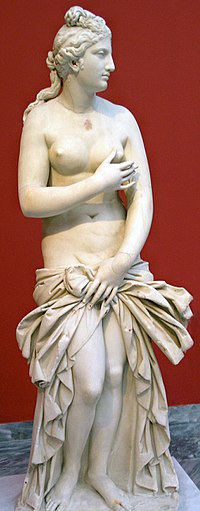Galeria Valeria Roman Empress 308-311AD Biography Ancient Coins
Numismatic Investment
Buy
Galeria Valeria Roman Empress coins, and read the biography of
the rare empress online, along with a video biography presentation.
Explore a selection of other authentic ancient Roman, Greek and
Byzantine coins available for sale. Find more rare and high-quality
ancient silver Roman coins by viewing the entire selection of thousands
of ancient Greek, Roman, Byzantine and Medieval coins online.


Example of Authentic Ancient
Coin of:
Galeria Valeria - Roman Empress - Wife of Galerius
- Daughter of Diocletian -
Bronze Follis Cyzicus mint: 308-309 A.D.
Reference: RIC 46 (Cyzicus)
GALVALERIAAVG - Diademed, draped bust right.
VENERIVICTRICI Exe: MKV - Venus standing left, holding apple and
raising skirt.
Venus
was a
Roman
goddess principally associated with
love,
beauty and
fertility, who played a key role in
many
Roman religious festivals and myths.
From the third century BC, the increasing
Hellenization of Roman upper classes
identified her as the equivalent of the
Greek goddess
Aphrodite.
 Her
cult began in
Ardea and
Lavinium,
Latium. On August 15, 293 BC, her
oldest known
temple was dedicated, and August 18
became a festival called the
Vinalia Rustica. After
Rome's
defeat at the
Battle of Lake Trasimene in the opening
episodes of the
Second Punic War, the Sibylline oracle
recommended the importation of the Sicillian Venus of Eryx; a temple to
her was dedicated on the
Capitoline Hill in 217 BC: a second
temple to her was dedicated in 181 BC. Her
cult began in
Ardea and
Lavinium,
Latium. On August 15, 293 BC, her
oldest known
temple was dedicated, and August 18
became a festival called the
Vinalia Rustica. After
Rome's
defeat at the
Battle of Lake Trasimene in the opening
episodes of the
Second Punic War, the Sibylline oracle
recommended the importation of the Sicillian Venus of Eryx; a temple to
her was dedicated on the
Capitoline Hill in 217 BC: a second
temple to her was dedicated in 181 BC.
Venus seems to have played a part in household or private religion of
some Romans. Julius Caesar claimed her as an ancestor (Venus Genetrix);
possibly a long-standing family tradition, certainly one adopted as such
by his heir
Augustus. Venus statuettes have been
found in quite ordinary household shrines (lararia). In fiction,
Petronius places one among the
Lares
of the
freedman
Trimalchio's household shrine.
Galeria Valeria (died 315) was the daughter of
Roman Emperor
Diocletian and wife of his co-emperor
Galerius.
Born as Valeria to Diocletian and
Prisca, she married Galerius in 293,
when her father elevated him to the position of Caesar. Prior to this
marriage, clearly organized to strengthen the bonds between the two
emperors, Galerius had to divorce his first wife,
Valeria Maximilla.
Galeria was sympathetic towards Christians, while Galerius persecuted
them.
Galeria was raised to the title of
Augusta and Mater Castrorum in
November 308. Since she gave no child to Galerius, Galeria adopted her
husband's illegittimate son,
Candidianus, as her own.
When Galerius died, in 311,
Licinius was entrusted with the care of
Valeria and her mother Prisca. The two women, however, fled from
Licinius to
Maximinus Daia, whose daughter was
betrothed to Candidianus. After a short time, Valeria refused the
marriage proposal of Maximinus, who arrested and confined her in
Syria and confiscated her properties.
At the death of Maximinus, Licinius ordered the death of both women.
Valeria fled, hiding for a year, until she was found in
Thessaloniki. She was captured by the
mob, beheaded in the central square of the city, and her body thrown in
the sea. Canonized as christian saint with her mother (see
Saint Alexandra).
|